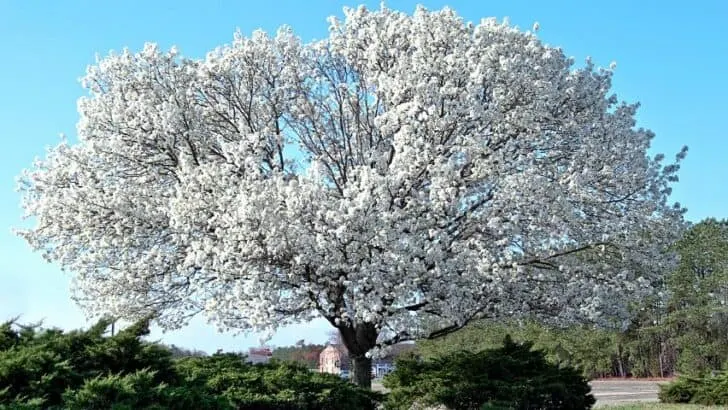In this article, I write about growing a dogwood tree. The Dogwood tree, also known as Cornus florida, belongs to the United States. It is an understory tree. These trees, therefore, prefer partial shade. No full sun.
Its different varieties can be found in almost every state of the country. While some trees are shrubs, others are deciduous trees and evergreens. Different cultivars have different flowers. They bloom starting in early spring.
Flowering dogwood, native to Virginia, has white and light-yellow flowers that bloom in spring.
Table of Contents
How to Grow and Take Care of Dogwood Trees?
To take care of a dogwood tree, ensure that you place it in partial shade. Where they get a maximum of 4-5 hours of direct sun. Plant these trees in soil rich in nutrients. Water once a week if there is insufficient rainfall. Well-drained soil is important for a healthy root system. Fertilize once in March and in July.

Dogwood Trees
Dogwood is also commonly known as the Hound’s Tree or the Whipple Tree due to its exceptionally strong hardwood.
This hardwood is sometimes used in expensive walking sticks and handling tools. Although this tree is mainly considered ornamental, its different varieties have many other uses.
The variety Cornus Kousa produces sweet fruit, which is widely used in making tropical puddings. One variety of the dogwood tree, called the Cornus Kousa, produces sweet fruits that are used for tropical puddings
Another variety, called Cornus Mas, produces a tart fruit that has a unique flavor. Cornus Mas is another variety of the dogwood tree that yields a tart-tasting and uniquely-flavored fruit
Cornus Officinalis has its uses in Chinese medicine (traditional). It treats minor knee and back pains and significant problems such as uterine bleeding and bladder incontinence. If you prefer to grow a dogwood tree with medicinal properties, go for Cornus Officinalis instead.
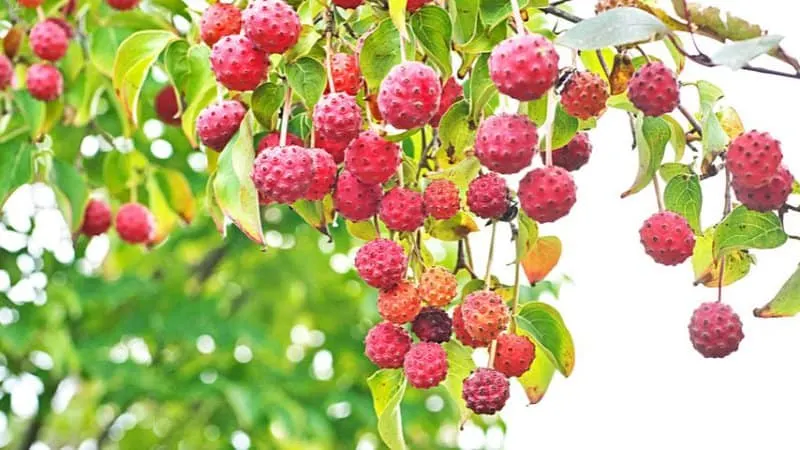
Another variety, called Cornus Mas, produces a tart fruit that has a unique flavor.
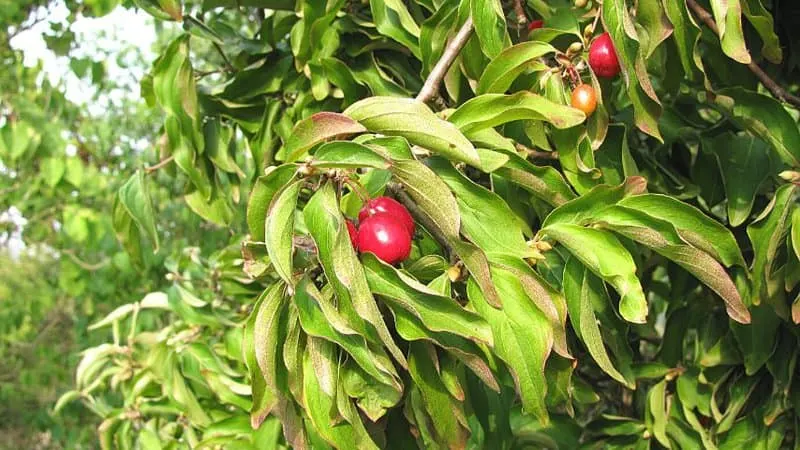
Cornus officinalis has its uses in Chinese medicine (traditional). It treats minor knee and back pains and significant problems such as uterine bleeding and bladder incontinence.
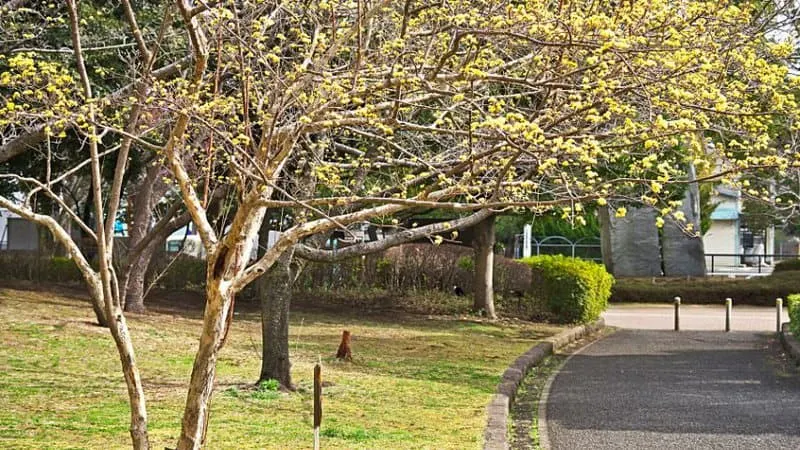
Dogwood Tree Care
Soil
Dogwood trees love soil that is rich in nutrients. Add compost or humus to make potting soil richer in nutrients.
Moreover, the soil should also have an excellent drainage capacity. Water should not remain close to the roots for an extended time. This leads to root rot.
The soil must have an acidic pH and should be sandy or loamy.
Temperature
According to Nasa, the temperature should not drop below -15°F (-26°C) for most Dogwood tree cultivars.
However, some, such as the Red Osier Dogwood, say the University of Cambridge, tolerates freezing temperatures below -452.2°F (-269°C).
The optimum temperature range is USDA hardiness zones 5 through 9.
Sunlight
Keep it in a spot where it gets partial sun.
To prevent sun scalding or burnt leaves, ensure dogwood trees get a max. of 4-5 hours of direct sunlight daily.
For the rest of the day, bright indirect light is best. This prevents the tree from having crispy leaves.
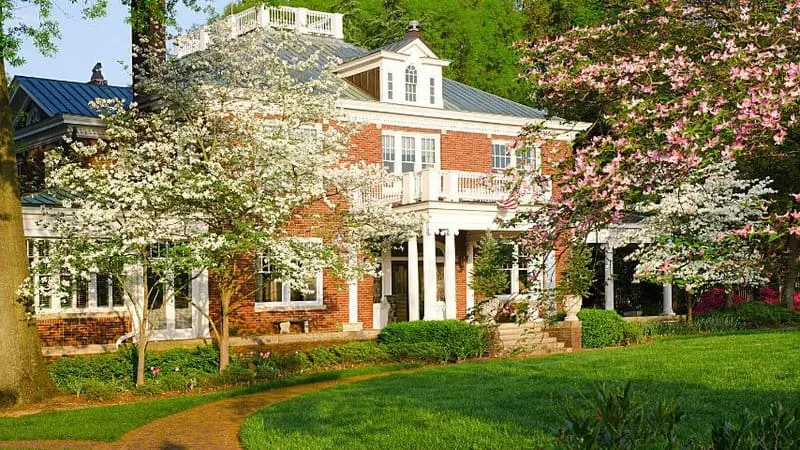
Watering Dogwoods
Water once a week if there is irregular rainfall. Dogwoods love moisture but not soggy soil.
The roots of the dogwood trees are shallow. Watering regularly helps to prevent the tree from drying out.
Water daily during hot weather. An expert tip is to water deeply during drought and heat.
Fertilizer
Fertilie twice. Once in spring and once in autumn. Use a balanced slow-release shrub or tree fertilizer.
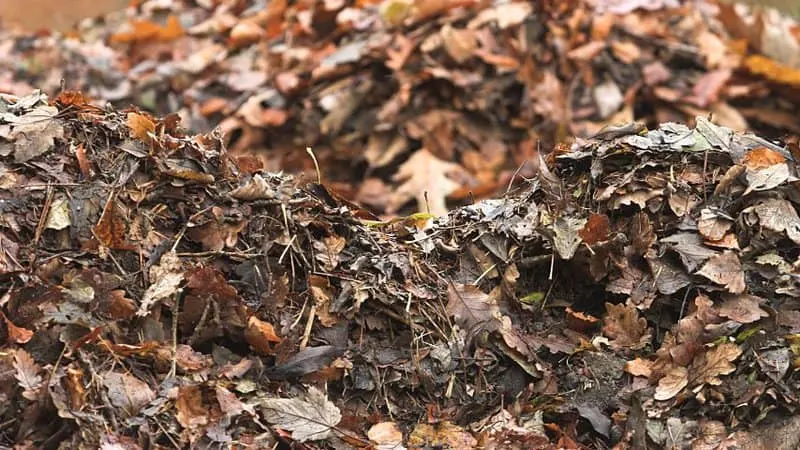
Prune
The best time to prune your dogwood tree is when they’re dormant. This is from late fall to early winter.
To improve the overall health of the tree, pruning is advised. Eliminate excess branches that absorb additional nutrients.
Propagation
To propagate, you can use hardwood and softwood cuttings. In addition, you can propagate dogwood trees through runners.
Flowering Dogwood Trees
Dogwood flowers in early to late spring. It produces white bracts with showy flowers. The bloom can also be pink or red.
Plant a Dogwood Tree
Plan a dogwood tree in a spot that has partial sun and shade. Make sure the tree has ample access to water. Autumn is ideal for planting. This gives the tree enough time to settle in its location before summer.
Before planting a dogwood tree, dig a large hole in the ground. Add compost.
Once the compost has settled in, put some leaf mulch around the compost. This way, the soil remains well-fed, and the roots are well-protected.
Put the root ball in the hole. Ensure it is kept about ¼ above ground level. Water the root ball generously.
Types of Dogwood (Cultivars)
The most common dogwood cultivars are:
- Pacific Dogwood (Cornus nuttallii)
- Pagoda Dogwood (Cornus alternifolia)
- Wolf Eyes Dogwood (Cornus florida ‘Wolf Eyes’)
- Kousa Dogwood (Cornus kousa)
- Arctic Fire Dogwood (Cornus stolonifera ‘Arctic Fire’)
- Chinese Dogwood (Cornus chinensis)
- Cherokee Princess Dogwood (Cornus florida ‘Cherokee Princess’)
- Stellar White Dogwood (Cornus x ‘Rutgan’)
- Stellar Pink Dogwood (Cornus x ‘Rutgan’)
- Cloud 9 Dogwood (Cornus x ‘Cloud 9’)
5 Common Plant Diseases With Cornus Florida and Pests
1. Crown Canker
Phytophthora cactorum, also known as crown canker, is one of the most severe diseases a dogwood tree can develop.
This disease initially manifests in fewer green leaves. It shrinks them into a dull, faded green. As the condition worsens, the dogwood tree branches fall off.
This disease becomes severe. Especially in dry seasons. When the tree does not get sufficient water to sustain itself.
The cause of this disease is a dead region in the lower half of the tree. It gradually traps the tree’s roots. It eventually kills the cambium. A tissue layer that is responsible for the growth of secondary cells.
The disease is mainly transmitted by open wounds in the lower region, sun scalds, or through bites from insects or animals.
Once infected, it is challenging to prevent the tree from dying. No dogwood tree should be planted in the same spot a dying one was.
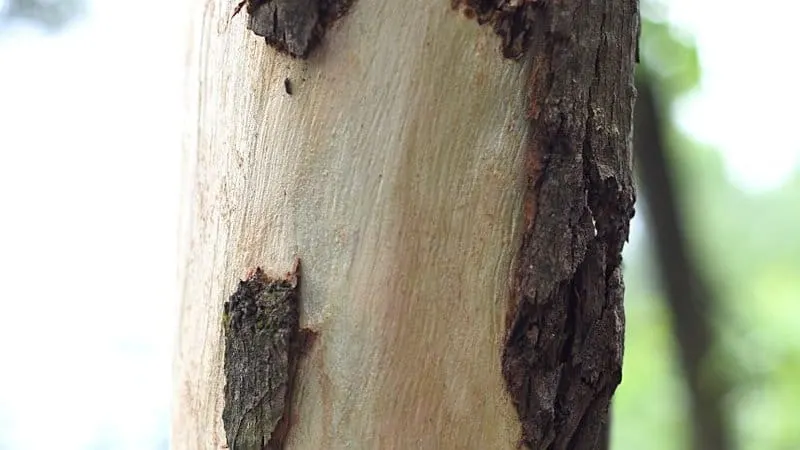
2. Scorched Leaves
If dogwood trees are allowed to sit in direct sunlight for an extended period, the leaves will scorch.
Keep these trees watered. Especially in summer and during dry phases. Otherwise, the leaves turn brown and crispy and fall off.
3. Sunscald
Sunscald in dogwood trees is also known as the ‘southwest injury.’ It typically occurs in the southwest direction of the tree.
It happens when the tree’s bark is exposed to winter sun for longer.
A discolored and deep wound appears on the bark’s outer portion. It gives room to insects and pathogens.
Sunscald may also be followed by cracking and peeling in hot, dry weather around the bark region.
4. Leaf Spots
Leaf spots, red or purple, do not do much harm other than marring the tree’s appearance.
This is more common in wet weather. When leaves absorb more water than usual. They develop these unpleasant-looking spots.
The spots should not be confused with dogwood anthracnose canker. This is highly deadly to the tree.
The canker is also known as Discula Destructiva. It produces small poisonous shoots in the lower region of the tree. This eventually causes the tree’s death.
5. Scale Insects
Scale insects, especially the cottony maple scale, are commonly found feeding on the dogwood leaves. Cottony maple scales are commonly found feeding on the dogwood tree’s leaves.
Scale insects are easy to take care of, as they only need to be flicked away with a pointed knife or a fingernail. Make sure to disinfect the knife after.
Regularly wipe the leaves with a light fabric dipped in soap water. This will keep the pests at bay.
You can also spray them with an effective insecticide or use beneficial nematodes.

Maintenance Tips
To grow and care for flowering trees such as the dogwood tree, do the following:
- Prune and discard dead leaves and branches throughout the year
- Fertilize twice a year around the planted tree
- Water when there is little to no rainfall
- Check for pests frequently
Frequently Asked Questions
When should you plant a dogwood tree?
The best time to grow a dogwood tree is in spring because the soil is still moist, and the growing season hasn’t started yet. Plant it in an area not directly exposed to sunlight. Clear any debris from the plantation site, ensuring that you water it regularly in the beginning.
Should I use coffee grounds on my Dogwood tree?
Since Dogwood trees are great lovers of acids, you can undoubtedly use coffee grounds on them to increase the soil’s quality and maximize their growth speed. Use small portions of coffee grounds on the soil’s surface and water the plant afterward.
What makes a Dogwood tree so special?
The most important thing about Dogwood trees is that they have both female and male reproductive organs. This means they’re capable of self-pollination and producing seeds on their own. Moreover, the Dogwood tree’s fruit is also famous because it is an essential food source for many bird species.
For how long can a Dogwood tree survive?
The Dogwood tree is known to live up to 80 years. This tree shows distinct changes in each season of the year. In spring, it bears flowers, grows foliage in summer, bears fruit in fall, and grows immense branches in winter. You can grow it in the USDA hardiness zones of 5 to 9.
Why do my Dogwood trees keep dying?
If you think your dogwood trees are showing signs of damage, it can be due to several reasons. Accurately diagnosing the problem means a more effective treatment. Some common reasons for the dogwood tree’s disease are sunscalding, rotten roots, and insufficient water.
Dogwoods are the perfect choice for your garden with their large green leaves and showy white flowers. Now that you know how to grow and take care of Dogwood trees, you are on the right path.

Daniel has been a plant enthusiast for over 20 years. He owns hundreds of houseplants and prepares for the chili growing seasons yearly with great anticipation. His favorite plants are plant species in the Araceae family, such as Monstera, Philodendron, and Anthurium. He also loves gardening and is growing hot peppers, tomatoes, and many more vegetables.

